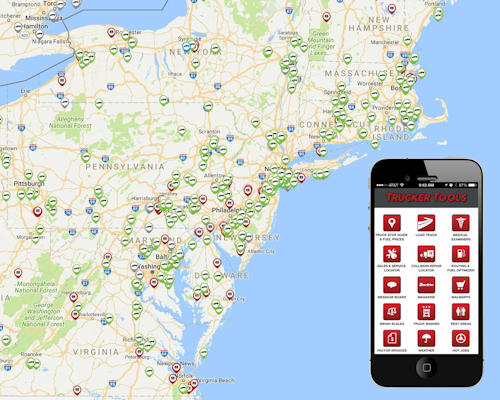In 2018, the pressures on truck capacity picked up right where they left off.
Spot market rates climbed to record levels in December 2017, according to the DAT Freight Index. DAT Solutions also reported nine loads were available for every truck in its network — its highest monthly average in history.

Smart Capacity is a new predictive freight matching platform from Trucker Tools.
With shippers and third-party logistics (3pl) providers scrambling to find capacity and lock it down, 2018 could be the year of freight matching technology.
Several years ago, a number of shippers and 3pls began to use shipment visibility platforms. The technology relies on the GPS from drivers’ phones, from fleet telematics systems, and signals from cell towers to eliminate the manual “check calls” and traditional EDI status (214) updates.
Some of these shipment visibility platforms are now using real-time locations and hours-of-service data to bring shippers and 3pls out of the Dark Ages of freight matching, says Ken Wood, executive vice president of product management for Descartes.
Rather than use traditional load boards and waiting for carriers to search for loads and respond, the latest technologies can find capacity in freight networks several days in advance.
This new model of freight matching uses big data and predictive analytics to find and secure capacity days in advance, he says.
Descartes is a supplier of cloud-based routing, mobile and telematics applications. The company acquired MacroPoint in August 2017. MacroPoint is an electronic transportation network that provides location-based truck tracking and predictive freight capacity data content.
Beyond using location data to match freight, carriers and drivers can share the hours they have, and will have available, directly from their ELDs with their customers to increase the confidence of freight matching.
“I think ELDs are crucial to solving the capacity problem,” Wood says.

Photo courtesy of Barton Logistics
Wood also sees new opportunities for shippers and 3pls to use predictive freight matching technology to collaborate, rather than compete, for available capacity in their networks.
In the freight forwarding world it is common for brokers to purchase capacity from airlines and exchange it with other brokers. For small and mid-size 3pls to compete with larger competitors, Wood believes a similar model would make sense where future capacity could be purchased and exchanged.
“Maybe better technology solutions can allow that to happen,” he says.
Making capacity smart
Last fall, Trucker Tools announced a predictive freight matching platform called Smart Capacity. After watching a demo in January 2018, Triple T Transport, a mid-size 3pl, gave the product a try.
The technology utilizes the Trucker Tools driver smartphone app which nearly 500,000 drivers use for trip planning. The app increases the probability that owner operators and small-carrier drivers will stay connected with Triple T and use the integrated Smart Capacity feature to find loads.
Drivers can use the app to find loads from other 3pls too, but this is a better solution for Triple T than developing its own driver app, says Darin Puppel, president of the Columbus, Ohio-based company, as “carriers do not want to use a multitude of different apps to find a load.”
Triple T has visibility of forward-looking freight matching recommendations on a map in the user dashboard of its Smart Capacity’s web portal.
“We wanted a platform where our preferred carriers give us the first shot at matching loads. Smart Capacity does that for us, as it allows us to effectively work further into the future, increasing the probability of booking with our preferred carriers before they start looking for loads from others,” says Puppel.
For more insight on how Triple T Transport uses Smart Capacity technology, view a PDF of a recent case study published by Trucker Tools here.
Dynamic load matching
As the trucking industry completes its conversion to ELDs, more companies will be creating freight matching platforms that utilize the locations and hours-of-service data to give carriers load offers.

Photo courtesy of Load Delivered
Konexial developed an ELD that it offers to carriers for a low-cost monthly subscription. The ELD, called My20, includes a smartphone app and wireless device that connects to the diagnostics port of a vehicle.
The app updates a dynamic load matching platform called GoLoad that uses location, hours and economic factors — the rate the carrier/driver is looking for — to send relevant load matching opportunities directly to the smartphone app.
The GoLoad model inverts the brokerage and load board process, says Ken Evans, chief executive of Konexial. Instead of carriers having to search for loads, it sends relevant opportunities to carriers.
The My20 app is more than an ELD with an integrated load matching tool. It also has turn-by-turn routing, fuel discounts, and instant connectivity with shippers and 3pls for dispatch and communications, he says. And for fleets, Konexial has a web-based compliance and fleet management platform called My20 Tower.
Currently, more than 1,300 different carriers — mostly owner operators and small carriers with less than 10 trucks, are subscribed to My20.
“The idea is to give someone a single tool they can use to get all the inputs to run their business better,” he says.
Besides getting locations and hours-of-service data from the My20 ELD, the company’s GoLoad platform can be extended to other ELD providers and telematics companies through APIs, he says.
To use GoLoad to find capacity, shippers and 3pls have to agree to certain terms, explains Evans. The fuel surcharge is set by fuel prices in the lane on the day of shipments. Detention at loading and unloading facilities is automatically billed at the rate of $200 per hour for any time the driver is detained beyond 90 minutes combined at pickup and drop-off locations.
Freight payments are sent to the carrier 48 hours after the carrier uploads a proof-of-delivery image.
Rather than limit capacity, as many believed the ELD rule would do, the technology seems to have put carriers in the driver’s seat by sharing the capacity they have available to shippers and 3pls days in advance. This new development could eliminate the time they spend searching for loads.
Original Source: https://www.ccjdigital.com/capacity-crunch-breeds-new-freight-matching-tech/
